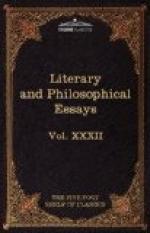If we now pass to the French romance of Parceval, we find that all this phantasmagoria clothes a very different significance. The lance is that with which Longus pierced Christ’s side, the Grail or basin is that in which Joseph of Arimathea caught the divine blood. This miraculous vase procures all the good things of heaven and earth; it heals wounds, and is filled at the owner’s pleasure with the most exquisite food. To approach it one must be in a state of grace; only a priest can tell of its marvels. To find these sacred relics after the passage of a thousand trials,—such is the object of Peredur’s chivalry, at once worldly and mystical. In the end he becomes a priest; he takes the Grail and the lance into his hermitage; on the day of his death an angel bears them up to Heaven. Let us add that many traits prove that in the mind of the French trouvere the Grail is confounded with the eucharist. In the miniatures which occasionally accompany the romance of Parceval, the Grail is in the form of a pyx, appearing at all the solemn moments of the poem as a miraculous source of succour.
Is this strange myth, differing as it does from the simple narrative presented in the Welsh legend of Peredur, really Cymric, or ought we rather to see in it an original creation of the trouveres, based upon a Breton foundation? With M. de la Villemarque we believe that this curious fable is essentially Cymric. [Footnote: See the excellent discussion of this interesting problem in the introduction to “Contes populaires des anciens Bretons” (pp. 181 et seq.).] In the eighth century a Breton hermit had a vision of Joseph of Arimathea bearing the chalice of the Last Supper, and wrote the history called the Gradal. The whole Celtic mythology is full of the marvels of a magic caldron under which nine fairies blow silently, a mysterious vase which inspires poetic genius, gives wisdom, reveals the future, and unveils the secrets of the world. One day as Bran the Blessed was hunting in Ireland upon the shore of a lake, he saw come forth from it a black man bearing upon his back an enormous caldron, followed by a witch and a dwarf. This caldron was the instrument of the supernatural power of a family of giants. It cured all ills, and gave back life to the dead, but without restoring to them the use of speech—an allusion to the secret of the bardic initiation. In the same way Perceval’s wariness forms the whole plot of the quest of the Holy Grail. The Grail thus appears to us in its primitive meaning as the pass-word of a kind of free-masonry which survived in Wales long after the preaching of the Gospel, and of which we find deep traces in the legend of Taliessin. Christianity grafted its legend upon the mythological data, and a like transformation was doubtless made by the Cymric race itself. If the Welsh narrative of Peredur does not offer the same developments as the French romance of Parceval, it is because the Red Book of Hergest gives us an




